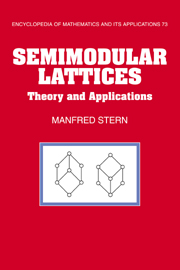Book contents
- Frontmatter
- Contents
- Preface
- 1 From Boolean Algebras to Semimodular Lattices
- 2 M-Symmetric Lattices
- 3 Conditions Related to Semimodularity, 0-Conditions, and Disjointness Properties
- 4 Supersolvable and Admissible Lattices; Consistent and Strong Lattices
- 5 The Covering Graph
- 6 Semimodular Lattices of Finite Length
- 7 Local Distributive
- 8 Local Modularity
- 9 Congruence Semimodularity
- Master Reference List
- Table of Notation
- Index
- Frontmatter
- Contents
- Preface
- 1 From Boolean Algebras to Semimodular Lattices
- 2 M-Symmetric Lattices
- 3 Conditions Related to Semimodularity, 0-Conditions, and Disjointness Properties
- 4 Supersolvable and Admissible Lattices; Consistent and Strong Lattices
- 5 The Covering Graph
- 6 Semimodular Lattices of Finite Length
- 7 Local Distributive
- 8 Local Modularity
- 9 Congruence Semimodularity
- Master Reference List
- Table of Notation
- Index
Summary
Modular Pairs and Modular Elements
Summary. Modular pairs were defined in Section 1.2, and later several properties were given, including a characterization via certain mappings (see Section 1.9). Here we give another characterization in terms of forbidden pentagons and some consequences. We present the parallelogram law, which is an extension of the isomorphism theorem (Dedekind's transposition principle) for modular lattices.
Blyth & Janowitz [1972], Theorem 8.1, p. 72, provided the following characterization of modular pairs in terms of relative complements, that is, excluding certain pentagon sublattices.
Theorem 2.1.1 Let a, b be elements of a lattice L. Then a M b holds if and only if L does not possess a pentagon sublattice {a ∧ b,a,x, y, a ∨ x = a ∨ y} with x < y ≤ b (see Figure 2.1).
Proof. If a M b and there exists a sublattice of the indicated form, then x < y ≤ b and thus y = (x ∨ a) ∧ y = (x ∨ a) ∧ b ∧ y = x ∨(a ∧ b)∧ y = x ∧ y = x, a contradiction. If a M b fails, then we can find an element t < b such that t ∨ (a ∧ b) < (t ∨ a) ∧ b. Setting x = t ∨ (a ∧ b) and y = (t ∨ a) ∧ b, we get a ∧ b ≤ a ∧ y = a ∧[(t ∨ a) ∧ b] = a ∧ b and hence a ∧ b = a ∧ y = a ∧ x. Dually we get a ∨ x = a∨ y = a ∨ t. Thus we obtain a pentagon sublattice of the required form.
Information
- Type
- Chapter
- Information
- Semimodular LatticesTheory and Applications, pp. 73 - 109Publisher: Cambridge University PressPrint publication year: 1999
